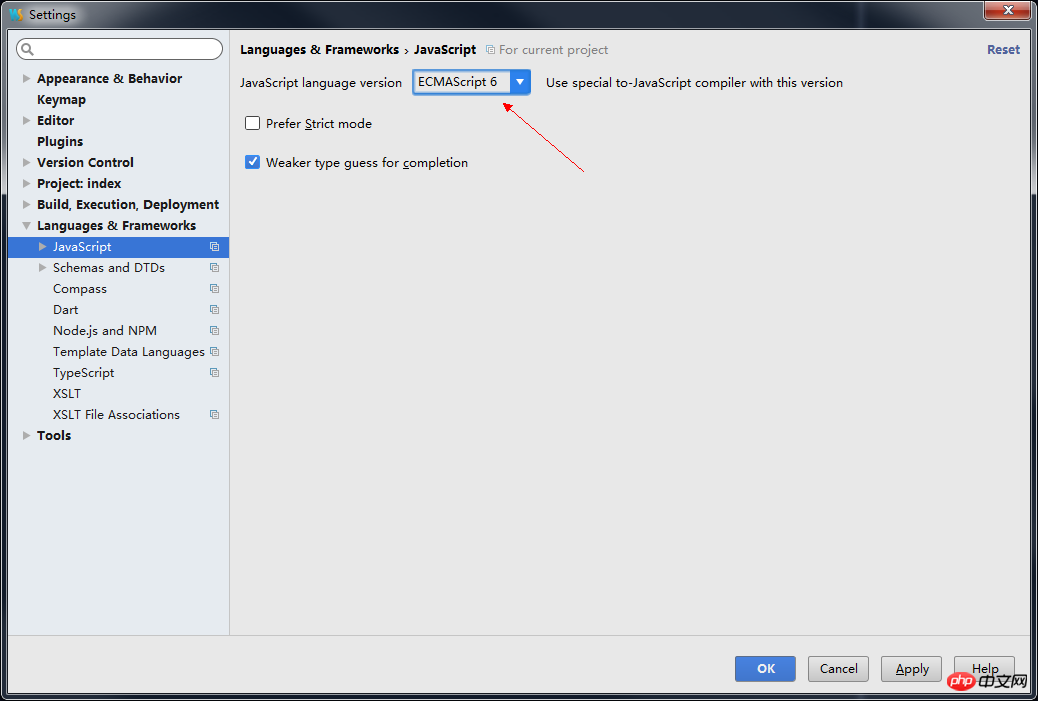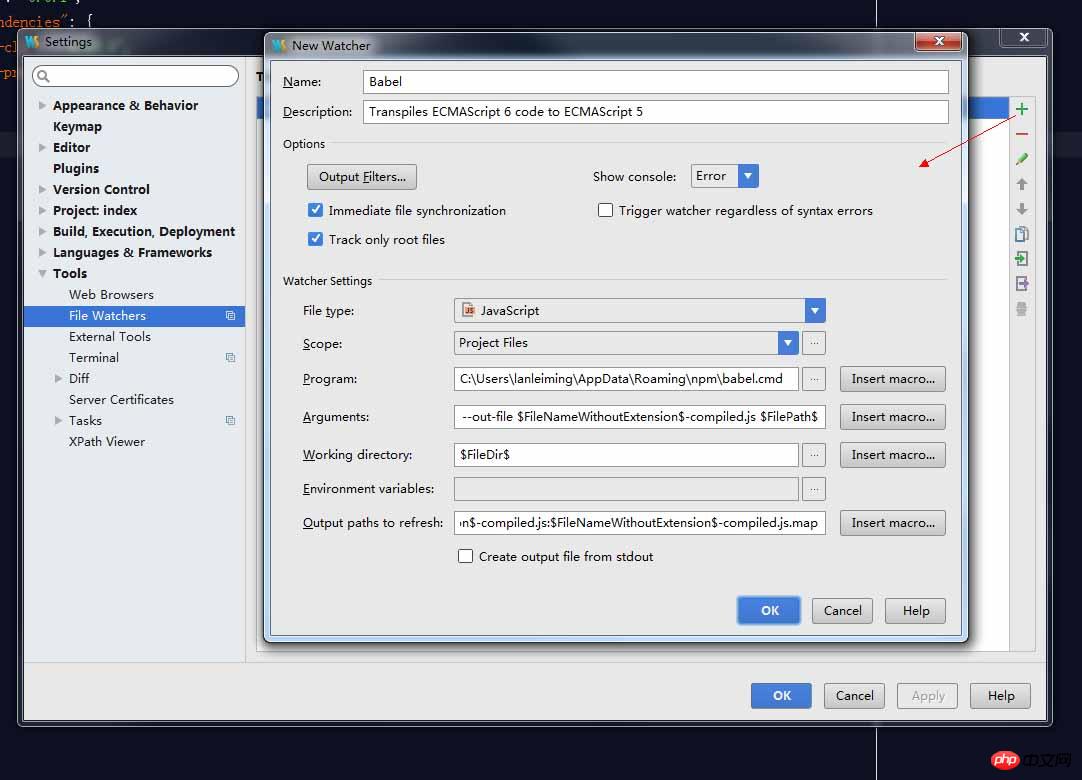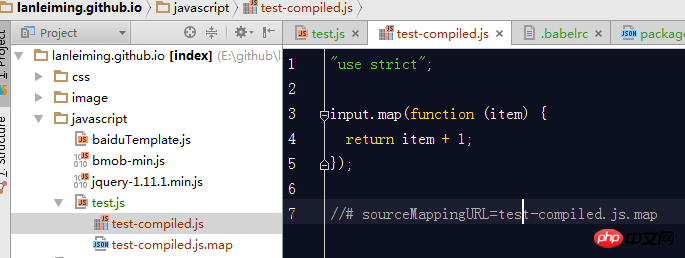WebStorm ES6 syntax settings and introduction to babel usage
The following editor will bring you an article on WebStorm ES6 syntax support settings & babel usage and automatic compilation (detailed explanation). The editor thinks it’s pretty good, so I’ll share it with you now and give it as a reference. Let’s follow the editor to take a look.
1. Grammar support settings

2. Babel installation
1. Global installationnpm install -g babel-cli
npm install --save-dev babel-cli
3. Basic usage of Babel
# 转码结果输出到标准输出 babel example.js # 转码结果写入一个文件 # --out-file 或 -o 参数指定输出文件 babel example.js --out-file compiled.js # 或者 babel example.js -o compiled.js # 整个目录转码 # --out-dir 或 -d 参数指定输出目录 babel src --out-dir lib # 或者 babel src -d lib # -s 参数生成source map文件 babel src -d lib -s
4. Using babel in webstorm
0. Create a new test.js file , used as a test caseinput.map(item => item + 1);
{ "name": "application-name", "version": "0.0.1"}npm install --save-dev babel-cli
 #4. Add the configuration file
#4. Add the configuration file
.babelrc<span style="color:#000000;font-family:NSimsun"></span>Babel’s configuration file is
.babelrc<span style="font-family:NSimsun">, stored in the root directory of the project. The first step in using Babel is to configure this file. </span>This file is used to set transcoding rules and plug-ins. The basic format is as follows.
{ "presets": [], "plugins": []}5. Set the transcoding rules
presets<span style="font-family:NSimsun"> field to set the transcoding rules , the official provides the following rule sets, you can install them according to your needs. </span>
# ES2015转码规则 npm install --save-dev babel-preset-es2015 # react转码规则 npm install --save-dev babel-preset-react # ES7不同阶段语法提案的转码规则(共有4个阶段),选装一个 npm install --save-dev babel-preset-stage-0 npm install --save-dev babel-preset-stage-1 npm install --save-dev babel-preset-stage-2 npm install --save-dev babel-preset-stage-3
We need to install es2015, the command is as follows:
npm install --save-dev babel-preset-es2015
6. Update the configuration file.babelrc
Save the corresponding rules to the configuration file.
{
"presets": [
"es2015"
],
"plugins": []
}7. Complete, check the effect
After the above steps are completed, you can automatically convert the ES6 code to ES5 after modifying the code.

5. Use the command to manually compile the code1. Change the package.json file
{
"name": "application-name",
"version": "0.0.1",
"devDependencies": {
"babel-cli": "^6.26.0"
},
"scripts": {
"build": "babel src -d lib"
}
}2. Use the command to generate ES5 code
npm run build
3. The effect
will be The code in the directory is compiled into the lib directory.
The above is the detailed content of WebStorm ES6 syntax settings and introduction to babel usage. For more information, please follow other related articles on the PHP Chinese website!

Hot AI Tools

Undresser.AI Undress
AI-powered app for creating realistic nude photos

AI Clothes Remover
Online AI tool for removing clothes from photos.

Undress AI Tool
Undress images for free

Clothoff.io
AI clothes remover

AI Hentai Generator
Generate AI Hentai for free.

Hot Article

Hot Tools

Notepad++7.3.1
Easy-to-use and free code editor

SublimeText3 Chinese version
Chinese version, very easy to use

Zend Studio 13.0.1
Powerful PHP integrated development environment

Dreamweaver CS6
Visual web development tools

SublimeText3 Mac version
God-level code editing software (SublimeText3)

Hot Topics
 1382
1382
 52
52
 How to solve webstorm crash
Apr 08, 2024 pm 02:24 PM
How to solve webstorm crash
Apr 08, 2024 pm 02:24 PM
Steps to resolve WebStorm crash issues: Check for updates; Restart your computer; Disable plugins; Reset settings; Clear cache; Check firewall and antivirus software; Reinstall WebStorm; Contact support.
 How to run jsp project in webstorm
Apr 08, 2024 pm 03:39 PM
How to run jsp project in webstorm
Apr 08, 2024 pm 03:39 PM
You can run a JSP project in WebStorm by following these steps: Create a Java Web project. Configure the project and add Web and Java EE facets. Create the JSP file in the "src/main/webapp" directory. Write JSP code including HTML, Java and JSP tags. Deploy and run the project. Access the JSP page by entering the application context root in your browser.
 How to connect to the database in webstorm
Apr 08, 2024 pm 03:42 PM
How to connect to the database in webstorm
Apr 08, 2024 pm 03:42 PM
You can use WebStorm to connect to the database through the following steps: 1. Open the database tool window; 2. Create a data source; 3. Connect to the data source; 4. Query the database; 5. Browse tables and data; 6. Edit database objects; 7. Manage Users and permissions.
 How to restart webstorm
Apr 08, 2024 pm 07:15 PM
How to restart webstorm
Apr 08, 2024 pm 07:15 PM
To restart WebStorm, follow these steps: Use the shortcut keys: Windows/Linux: Ctrl + Shift + A, macOS: Cmd + Shift + A. Enter "restart" in the search field and select "Restart". Using the menu: Click the File menu and select Restart under Reload. Using Task Manager: In Task Manager or Force Quit the application window, select the WebStorm process and click Restart or Restart.
 How to automatically wrap lines in webstorm
Apr 08, 2024 pm 03:48 PM
How to automatically wrap lines in webstorm
Apr 08, 2024 pm 03:48 PM
WebStorm provides automatic line wrapping, which breaks code into separate lines to improve readability. Its rules include: 1. Branch long expressions and statements; 2. Branch method calls; 3. Branch functions and class definitions. User-customizable settings such as maximum line length, indentation type, and shortcut keys. However, word wrapping may not work with single-line comments or string literals and will affect code formatting, so careful review is recommended before application.
 Where is webstorm's automatic line wrapping?
Apr 08, 2024 pm 08:09 PM
Where is webstorm's automatic line wrapping?
Apr 08, 2024 pm 08:09 PM
Automatic line wrapping can be set in WebStorm by following these steps: Check the "Wrap lines" checkbox and set the maximum line width. Select automatic line wrapping rules: None, line wrapping at any position, or line wrapping after keywords. Optional settings: retain manual line wrapping and automatic line wrapping after carriage return. Apply the settings and close the settings window. Note: This setting applies to all file types and can be set individually for specific file types.
 Which one is easier to use, webstorm or vscode?
Apr 08, 2024 pm 07:33 PM
Which one is easier to use, webstorm or vscode?
Apr 08, 2024 pm 07:33 PM
For developers who focus on web development and pursue deep functionality, WebStorm is a better choice; while users who value customizability, lightweightness, and multi-language support are more suitable for VSCode.
 How to log in to webstorm
Apr 08, 2024 pm 04:45 PM
How to log in to webstorm
Apr 08, 2024 pm 04:45 PM
Steps to log in to WebStorm: 1. Open WebStorm; 2. Select a GitHub or JetBrains account to log in; 3. Enter credentials; 4. Authorize access to the account; 5. Complete login.




